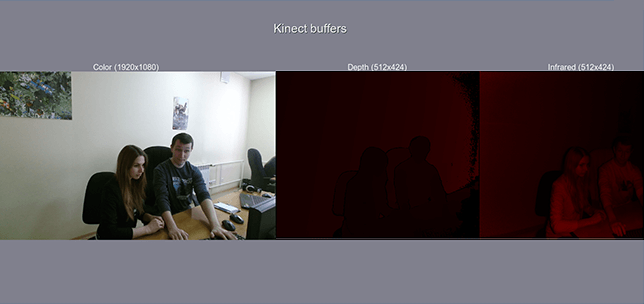Kinect2 Plugin
Kinect 2.0 is a motion sensing input device that tracks the human body motions and translates this data to 3D worlds. The sensor detects joints therefore building a virtual 3D skeleton.
The Kinect2 plugin is used for receiving already detected data from a Kinect2 sensor. The plugin is provided as an add-on.

Minimum capabilities:
- 64-bit (x64) processor
- Physical dual-core 3.1 GHz (2 logical cores per physical) or faster processor
- USB 3.0 controller dedicated to the Kinect for Windows v2 sensor or the Kinect Adapter for Windows for use with the Kinect for Xbox One sensor
- 4 GB of RAM
- Graphics card that supports DirectX 11
- Windows 8 or 8.1, or Windows Embedded 8
- Kinect SDK 2.0
See Also#
- Kinect Class (engine.kinect) functions
-
Samples on the plugin usage:
- <UnigineSDK>/data/samples/plugins/kinect_00 that shows all 3 buffers (color, depth, IR range)
- <UnigineSDK>/data/samples/plugins/kinect_01 that shows all detected virtual skeletons
- <UnigineSDK>/data/samples/plugins/kinect_02 that shows all detected faces
Launching Kinect2 Plugin#
To use the plugin, you should perform the following:
-
Specify the extern_plugin command line option on the application start-up:
Shell commandsmain_x64 -extern_plugin "Kinect"
Implementing Application Using Kinect2 Plugin#
The plugin can receive the following types of data:
- Buffers: color, depth, IR range.
- Virtual skeletons (up to 6 skeletons can be detected): position and orientation of bones in a 3D world, position of hands, accuracy of each bone detection.
- Faces (up to 6 faces can be detected): face boundaries and facial key points (eyes, mouth, nose) in coordinates of color and IR buffers, features (eye glasses, smile, closed eyes).
When implementing an application using the plugin, it is necessary to call the init() function with the required arguments on engine initialization and the shutdown() function on engine shutdown. For example:
#ifdef HAS_KINECT
int init () {
kinect::init(KINECT_STREAM_INFRARED | KINECT_STREAM_DEPTH | KINECT_STREAM_COLOR);
return 1;
}
int update() {
// update logic
// here you can, for example, show the contents of the required buffers
return 1;
}
void shutdown() {
kinect::shutdown();
return;
}
#else
int init() {
Log::warning("No kinect plugin detected");
return 1;
}
int shutdown() {
return 1;
}
#endif